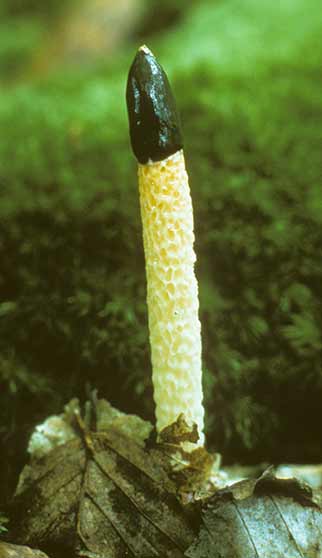Dog Stinkhorn (Mutinus caninus)

woodland at Park Hill
Dog Stinkhorn: it's an unfortunate name but so descriptive. Dog epithets were often attached to species perceived to be inferior to others - such as dog rose, dog violet and dog's mercury - and this in part may be the case with Dog Stinkhorn - an inferior version of the Stinkhorn.
Apart from in size, the Dog Stinkhorn is similar in many ways to its relative. It is a woodland inhabitant that grows amongst leaf litter below oak, beech or pine, life starts as a semi-submerged egg and it has a cap coated in dark olive, spore-bearing slime, a feature designed to attract insects that will carry off, and thereby distribute, the spores.
Beneath the Dog Stinkhorn's slime, though, is a slender, conical, orange-red head atop an at first whitish then pale yellow buff to bright orange, equally slender, hollow stem that grows to a length of up to 12 centimetres.
And whilst the stinkhorn is widespread and relatively common in the New Forest, the Dog Stinkhorn is far less frequently encountered, maybe in part because the fetid aroma emitted by the Dog Stinkhorn lacks the strength of that associated with the larger species and consequently does not tend to attract human attention. (Dog Stinkhorns emit a slight sickly smell said to be reminiscent of cat's faeces)!
The Dog Stinkhorn can be found primarily in autumn. It is not edible.
Warning: refer to a good, comprehensive fungus field guide to confirm identification, and only eat those species known without any doubt whatsoever to be edible - people have died after eating certain poisonous specimens.
References:
Mushrooms and other Fungi of Great Britain and Europe - Roger Phillips
The Mushrooms and Toadstools of Britain and North-western Europe - Marcel Bon
Fungi of Britain and Europe - Stefan Buczacki and John Wilkinson
The MacDonald Encyclopedia of Mushrooms and Toadstools - Giovanni Pacioni
Fungi of the New Forest: A Mycota - Edited by Gordon Dickson and Ann Leonard
A Passion for Mushrooms - Antonio Carluccio
More links
Other related links
Search this site

Sadly, 58 animals were killed - 35 ponies, 13 cows, 8 donkeys and 2 sheep, whilst a further 32 were injured - 3 pigs, 9 donkeys, 11 cows and 9 ponies.
(Forty-three accidents occurred in daylight, 15 at twilight and 101 in the dark. Twenty-seven accidents were not reported by the driver involved).
Here's just one horrific example - Three donkeys killed in collision with van at notorious New Forest blackspot (Advertiser and Times)

